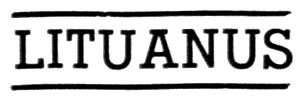
September, 1958 Vol. 4, No. 3
Managing Editor P. V. Vygantas
 |
www.lituanus.org |
| Copyright
© 1958 Lithuanian
Students Association, Inc. September, 1958 Vol. 4, No. 3 Managing Editor P. V. Vygantas |
|
Lithuanian and Latin
Dr. ANTANAS KLIMAS
Dr.
ANTANAS KLIMAS,
author of numerous articles, completed his graduate studies at the
University of Pennsylvania in Philadelphia, where he was an instructor
in German. Currently he is an assistant professor of German at the
University of Rochester, N. Y.
During the age of Romanticism, many
Lithuanian
patriots believed that the Lithuanians are descendants of the ancient
Romans. A theory was devised that the whole Lithuanian nation was the
offshot of a splinter group of Romans who fled internal strife in Rome
itself and, around the beginning of the Christian era or even earlier,
ended up on the shores of the Baltic Sea and along the Nemunas River.
They liked the country and settled there permanently. In time their
language changed and became... Lithuanian.
The principal reason
for the promulgation of this theory was the national pride of the
Lithuanians, who had just (1795) lost their political independence
after having been for several centuries (ca. 12001795) a great and
powerful kingdom. Although politically it was Russia that occupied
Lithuania, culturally it was Polish influence that was creeping into
all aspects of life, especially In the schools and churches, the
newspapers and books. The Lithuanian aristocracy and intelligentsia
were rapidly polonized, since Poland was also occupied by Russia and
this common fate drew the leading classes of the two formerly
independent and powerful nations closer and closer together. The Poles
had become Christians about 400 years earlier than the Lithuanians, and
by the time the Lithuanians too were Christianized the Poles had
already developed their national cultural institutions to a high
standard. Most of the Polish aristocrats and intellectuals, and later
even the Polish masses, regarded the Lithuanian language as inferior to
their own. This was similar to the situation in Germany, where French
and Latin were considered much superior to German.1
After
Herder, the German writer, spread the idea that one language is as good
as another and that any nation, large or small, deserves to be honored
just as much as any other nation, a great patriotic movement sprang up
in Europe, and especially in Central, Eastern and Northern Europe. The
younger generation of each nation's intellectuals "returned home"
they took up the study of the history, literature, folklore and
language of their own people. This was true also in Lithuania.2
The glorification of Lithuania's past was an important feature of this
patriotic upsurge. Since documented Lithuanian history does not begin
until after 1000 A.D., the Lithuanian patriots invented a whole new
dynasty of Lithuanian kings purportedly descended directly from the
Roman settlers mentioned above. The Lithuanian language thus became a
younger "sister" or a "daughter" of Latin. They would quote such a
sentence as the Latin Tres
vires iugum trahunt (Three men are pulling a yoke), and
point out truthfully that it bears a close resemblance to the
modern Lithuanian Trys
vyrai jungą traukia. The cardinal numbers unus, duo, tres, quattuor,
quinque (Latin), vienas,
du, trys, keturi, penki (Lithuanian) also bear a very
great similarity.
It
is true that both Latin and Lithuanian have preserved many archaic
features in their phonology, morphology and word formation. Still, such
examples as the two given above show no closer a relationship between
Latin and Lithuanian than exists between any two Indo-Europe an
languages that have preserved such archaic features. Actually, all the
relationships and similarities that exist between Latin and Lithuanian
date back to the time when the two lanuages were still merely dialects
of the common Indo-European mother tongue. There are hardly any
distinctive common features that can be ascribed to Lithuanian and
Latin alone, to the exclusion of all the other Indo-European tongues.
In
vocabulary, there are certain words that are common to Latin and one
group of other Indo-European languages and certain other words that are
shared by Latin and another group of related languages.3 The ignis (fire) has
cognates In the Lithuanian ugnis
and the Indo-Iranian agnih,
while the Latin aqua
(water) has a cognate in the Gothic ahva
and practically nowhere else.4
As
has been mentioned, Latin and Lithuanian are both languages that have
preserved many archaic features. It is difficult to judge which is the
more archaic and therefore the more important for comparative
Indo-European studies. This much is clear, however: Latin is a dead
language, known to us only from documents, while Lithuanian is still
very much alive,5
full of dialectal
variety, changing and adapting itself to every requirement of the
modern age. Thus where Latin may be more valuable in research on the
Greek, Celtic, Germanic and of course Italic (Romance) languages,
Lithuanian is more valuable for the entire Indo-European field,
especially in studies of accentuation, syntax, dialectology, linguistic
geography, etc. Lithuanian is also very helpful in studies of the
Indo-European future tense,6
And where Latin is dead, the data of Lithuanian can be checked and
rechecked at will, since it is alive.
NOTES: